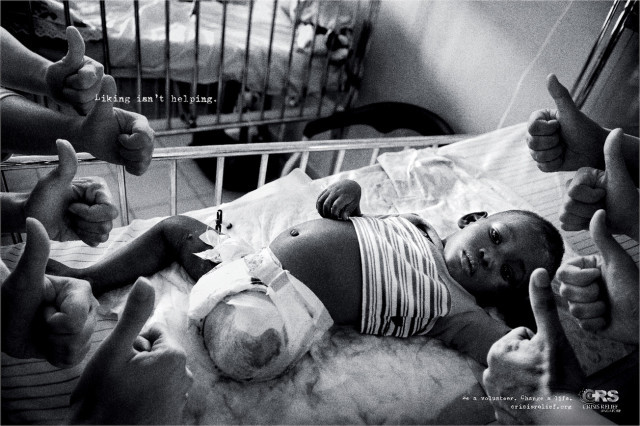"Liking isn't helping. Be a volunteer."
That's the key message in a campaign that Publicis Singapore cooked up for its client, Crisis Relief Singapore. The ads all feature a squadron of erect thumbs crowding a black and white image of incredible despair. The awards are landing left and right.
Yup, yet another use that Photoshop's creators probably never imagined.
This campaign reminds me of a former roommate of mine from Germany....
I grew up in the sticks of Arizona. That means I have an objectively slow Southwestern drawl.
One day I was making fun of my roommate's correct but mangled English. "Who are you to judge?" She finally asked me, annoyed. To her, I sounded like a Labrador retriever chewing a wad of gum.
See, I'm so inside my own world that sometimes I forget about the larger context. We all do, really. Stuck in our bubbles we sometimes forget that our ears aren't all attuned to the same frequency.
To me this campaign has an interesting and even important message that's been mangled by what I'll call its "unsustainable" tone. Let me explain.
First, the ads seem to say that just being engaged in a cause through social media -- say, by "Liking" it on Facebook -- isn't helpful at all.
If you care, you need to volunteer. Everything else is useless.
If they stopped right there, I would have been happy. Educating audiences that some ways to support a cause are more impactful than others is a terrific message.
I'm reminded about all those United Way "Give. Advocate. Volunteer." billboards. To me they've always seemed to suggest that it's all good, man, it's all good.
No, it's not all good. Some things are "gooder" than others -- at least if we're talking about measurable impact.
This is a powerful message, potentially.
The problem with the campaign is that the ads don't actually define volunteering at all... while suggesting that only volunteering will free us of the hypocrisy of caring from a distance.
So what exactly is volunteering, according to Crisis Relief? For that I have to click on the URL in the corner of the ad and go to the organization's website.
I can, for example, go to this page, where, ironically, I can find another volunteer opportunity that sounds a bit similar to, well, "liking" a cause:
As a Christian organization, we believe in the importance of praying for the organization. With that, we will like to gather volunteers who are passionate in praying and keen to lead prayer meetings to intercede for the organization.
Now, I'm not going to suggest that prayer is or is not an effective social change agent or disaster response strategy. Nope not going there with even a ten-foot pole. But it does seem hypocritical to come down harshly on those who support efforts to make a difference with their thumbs, while publicly endorsing those who put their hands together in prayer.
Oh, and did I mention that this organization also has a Facebook button right on its home page? What's that for?
This isn't the only organization that's conflicted about the role of social media engagement in marketing their cause. Because social media doesn't look like volunteering and fundraising, a lot of people have a hard time understanding its usefulness.
But the difference between, say, a skilled communications volunteer and someone who only shares or likes a story on social media is essentially one of degree -- not kind. They're both telling the organization's story in an external context, creating awareness, etc.
And let's be honest, going into a war zone or ground zero of a disaster isn't a possibility for, oh, pretty much everyone in the world. Which must leave other forms of involvement, right?
Meanwhile... there's also a tell-tale exploitative element about this campaign that to me marks it as the work of folks who don't live and breathe marketing for causes.
There's a voyeurism that can sometimes creep into cause campaigns that support communities vastly different than our own. And super-imposing a crowd of dumb, smiling thumbs onto scenes of ultimate suffering only reinforces, rather than critiques, that tendency.
In this cynical willingness to shame supporters against a backdrop of noble suffering, the ad reminded me of the Ad Council's "Don't Almost Give" from a few years back, which was one of the most relentlessly negative campaigns I've seen. (Here's another example.)
Shame, guilt, and fear can be very effective motivators for a nonprofit, but they tend to leave a bad smell in the nose of its supporters. It's the odor of slash and burn, an indicator of a completely unsustainable message. Over time, supporters will associate the organization with that smell and completely overlook all the good work they might do. And only time will tell, but messages that say "liking" a cause is a waste of time could make it harder for the organization -- and potentially many others -- to ever use social media again to build the base of their engagement ladders.
Bottom line from me: Slash and burn might help ad agencies sell junk food, but I don't think it's an effective long-term strategy for generating support or volunteers.
What do you think? Share your comments here.
